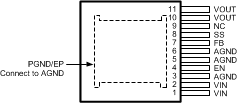SNVS667I February 2010 – March 2022 LMZ12010
PRODUCTION DATA
- 1 Features
- 2 Applications
- 3 Description
- 4 Revision History
- 5 Pin Configuration and Functions
- 6 Specifications
- 7 Detailed Description
- 8 Application and Implementation
- 9 Power Supply Recommendations
- 10Layout
- 11Device and Documentation Support
- 12Mechanical, Packaging, and Orderable Information
Package Options
Mechanical Data (Package|Pins)
- NDY|11
Thermal pad, mechanical data (Package|Pins)
Orderable Information
5 Pin Configuration and Functions
 Figure 5-1 11-PinNDY Package(Top View)
Figure 5-1 11-PinNDY Package(Top View)Table 5-1 Pin Functions
| PIN | TYPE | DESCRIPTION | |
|---|---|---|---|
| NAME | NO. | ||
| AGND | 3 | Ground | Analog ground — Reference point for all stated voltages. Must be externally connected to PGND (EP). |
| 5 | |||
| 6 | |||
| EN | 4 | Analog | Enable — Input to the precision enable comparator. Rising threshold is 1.274 V (typical). Once the module is enabled, a 13-µA source current is internally activated to facilitate programmable hysteresis. |
| FB | 7 | Analog | Feedback — Internally connected to the regulation amplifier and overvoltage comparator. The regulation reference point is 0.795 V at this input pin. Connect the feedback resistor divider between VOUT and AGND to set the output voltage. |
| NC | 9 | — | No connect — This pin must remain floating, do not ground. |
| PGND | — | Ground | Exposed pad/power ground — Electrical path for the power circuits within the module. PGND is not internally connected to AGND (pin 5, 6). Must be electrically connected to pins 5 and 6 external to the package. The exposed pad is also used to dissipate heat from the package during operation. Use 100 12-mil thermal vias from top to bottom copper for best thermal performance. |
| SS | 8 | Analog | Soft-start/track input — To extend the 1.6-ms internal soft start, connect an external soft-start capacitor. For tracking, connect to an external resistive divider to a higher priority supply rail. See Section 8.2.2. |
| VIN | 1 | Power | Input supply — Nominal operating range is 6 V to 20 V. A small amount of internal capacitance is contained within the package assembly. Additional external input capacitance is required between this pin and the exposed pad (PGND). |
| 2 | |||
| VOUT | 10 | Power | Output voltage — Output from the internal inductor. Connect the output capacitor between this pin and exposed pad (PGND). |
| 11 | |||